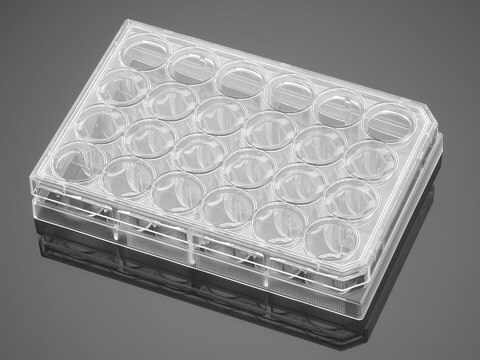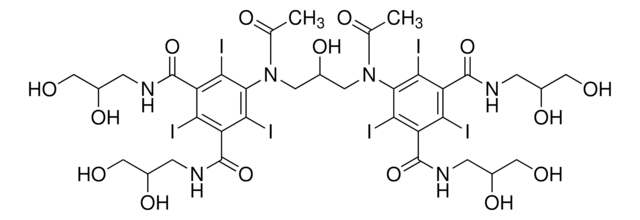推荐产品
相关类别
應用
Research Category
Cell Structure
Cell Structure
The CHEMICON® Cell Invasion Assay Kit is ideal for evaluation of invasive tumor cells. Each CHEMICON Cell Invasion Assay Kit contains sufficient reagents for the evaluation of 24 samples. The quantitative nature of this assay is especially useful for screening of pharmacological agents.
The CHEMICON Cell Invasion Assay Kit is intended for research use only; not for diagnostic or therapeutic applications.
The CHEMICON Cell Invasion Assay Kit is intended for research use only; not for diagnostic or therapeutic applications.
The Cell Invasion Assay Kit kuses a 24 well plate with 8 um pores, which is ideal for evaluation of invasive tumor cells.
包裝
24 assays
成分
Sterile 24-well Cell Invasion Plate Assembly: (Part No. 70019) Two 24-well plates with 12 ECMatrixTM-coated inserts per plate (24 coated inserts total/kit for 24 assays).
Cell Detachment Solution: (Part Number 90131) One bottle - 16 mL.
4X Cell Lysis Buffer: (Part Number 90130) One bottle - 16 mL.
CyQuant GR Dye 1: (Part Number 90132) One vial - 75 mL
Forceps: (Part Number 10203) One each.
Cell Detachment Solution: (Part Number 90131) One bottle - 16 mL.
4X Cell Lysis Buffer: (Part Number 90130) One bottle - 16 mL.
CyQuant GR Dye 1: (Part Number 90132) One vial - 75 mL
Forceps: (Part Number 10203) One each.
儲存和穩定性
Store kit materials at 2-8°C for up to their expiration date. Do not freeze.
法律資訊
CHEMICON is a registered trademark of Merck KGaA, Darmstadt, Germany
免責聲明
Unless otherwise stated in our catalog or other company documentation accompanying the product(s), our products are intended for research use only and are not to be used for any other purpose, which includes but is not limited to, unauthorized commercial uses, in vitro diagnostic uses, ex vivo or in vivo therapeutic uses or any type of consumption or application to humans or animals.
訊號詞
Danger
危險聲明
危險分類
Aquatic Acute 1 - Aquatic Chronic 2 - Eye Dam. 1
儲存類別代碼
10 - Combustible liquids
水污染物質分類(WGK)
WGK 2
Kate Lawrenson et al.
Carcinogenesis, 32(10), 1540-1549 (2011-08-24)
The biology underlying early-stage epithelial ovarian cancer (EOC) development is poorly understood. Identifying biomarkers associated with early-stage disease could have a significant impact on reducing mortality. Here, we describe establishment of a three-dimensional (3D) in vitro genetic model of EOC
Bei Wang et al.
Journal of hepatology, 50(3), 528-537 (2009-01-22)
Hepatocellular carcinoma (HCC) is one of the leading causes of cancer-related death worldwide with poor prognosis associated with tumor invasion and metastasis. The tumor suppressor p53 plays critical roles in tumor development, but there is increasing evidence for its involvement
Ping Feng et al.
The international journal of biochemistry & cell biology, 40(1), 98-109 (2007-08-19)
Cyr61/CCN1 is a secreted extracellular matrix associated protein involved in diverse biological functions and plays multiple roles in tumorigenesis. Cyr61 was down-regulated in HCC tumor tissues as observed in our previous cDNA microarray study, but its potential role in hepatocarcinogenesis
Xu-Jun He et al.
Cancer science, 103(12), 2082-2091 (2012-09-11)
Recent studies have shown that overexpression of regenerating gene family member 4 (REG4) is associated with the initiation and progression of pancreatic cancer. In our study, we explored the role of REG4 in the invasion of pancreatic cancer. Real-time PCR
Yukuan Feng et al.
European journal of cancer (Oxford, England : 1990), 47(15), 2353-2363 (2011-06-18)
Vascular endothelial growth factor C (VEGF-C) expression is associated with the malignant tumour phenotype making it an attractive therapeutic target. We investigated the biological roles of VEGF-C in tumour growth, migration, invasion and explored the possibility of VEGF-C as a
我们的科学家团队拥有各种研究领域经验,包括生命科学、材料科学、化学合成、色谱、分析及许多其他领域.
联系技术服务部门



